Chapter 1: Historical and Archaeological Resources
History of Ogunquit
Precontact
Colonial Era to Mid 19th Century
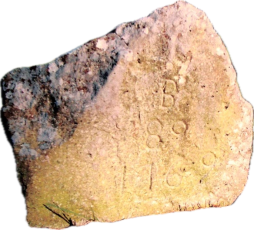
Beginning of the Artist Colony Era
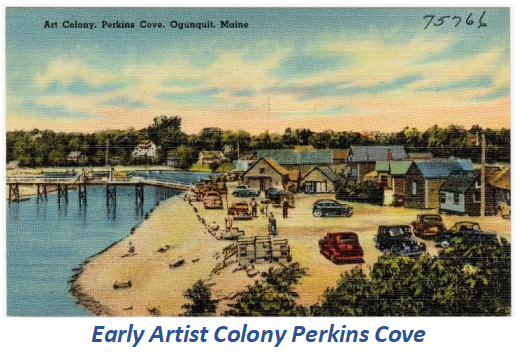
Protecting Natural Resources
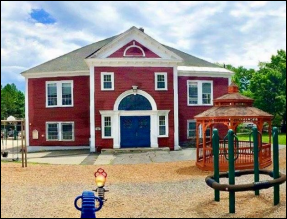

Tourism Growth
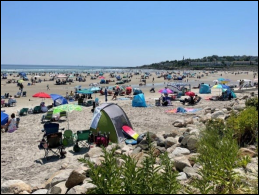

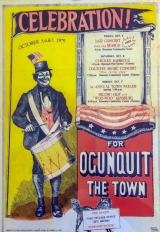
Town Incorporation
In 1974, S. Judson Dunaway generously donated a community center to the then-village of Ogunquit. Today the building serves as both a community center and Town hall. The Dunaway has also been used as the Police Station.
Ogunquit Celebration 1979
Ogunquit separated from Wells in 1980, incorporating as a stand- alone town, and celebrated with a parade through the village. The following decades have shown that Ogunquit continues to be unique among coastal Maine towns with its long stretch of beach forever preserved for the public as well as its rich arts and cultural heritage.
Rebuilding the Village
Rebuilding the Village
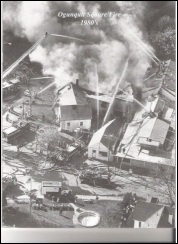
Population Growth and Preservation Efforts
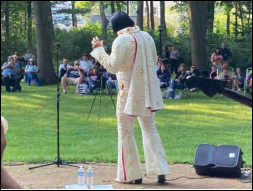
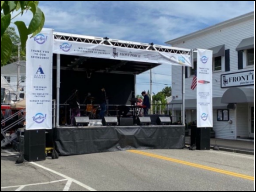
Continuing Preservation
Historic Resources
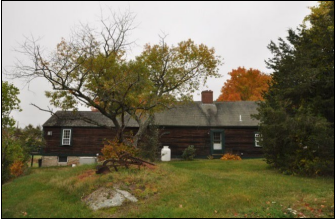
Ogunquit has eight sites listed in the National Register. They are:
- Goodale-Stevens Farm – circa 1720, locatedon the east side of North Village Road, just south of the Ogunquit
- Goodale-Bourne Farm – circa 1740, locatedon the west side of North Village
- Winn House – circa 1780, moved from itsformer location on Route 1 where the Gorges Grant Hotel is now to Obed’s Lane on
Winn House
the historic Jacobs lot in the 1980s. The building currently houses the Ogunquit Heritage Museum and its collection of historical artifacts, documents, and books. As noted earlier, it was also recognized by the Ogunquit voters as historic.
- Charles Perkins Homestead – circa mid to late1700s, located on the west side of Route 1 at Scotch Hill, probably built by David According to the OHPC, the Charles Perkins Homestead was
- demolished some years ago. Across the street, the David Maxwell homestead still exists as the store now known as Panache.
Ogunquit Memorial Library
- OgunquitPlayhouse, circa 1937, located on Route 1, was added to the Register in 1995 and elevated
- in 2015 to a “National Level of Significance”
- Ogunquit Memorial Library – circa 1897, located on thenorth side of Shore Road, was built by Nannie Conarroe in memory of her husband, George, along with a trust fund to maintain
- Colonial Inn – circa 1890, located on the east side of Shore Entered into the National Register on July 30th, 2012 under Entertainment and Recreation Criterion C. Architecture. This turn of the century hotel
- offers an important visual look back to summer hotels that provided escape from the unhealthy city heat from 1890 through 1960.
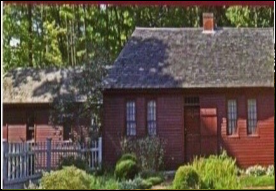
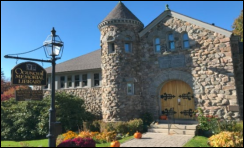
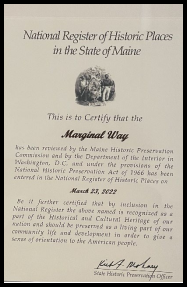
The Marginal Way was added to the Register in 2022. More information is available in the Appendices
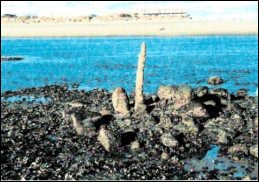
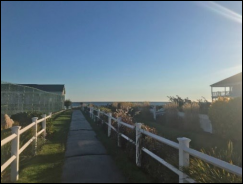
The OHPC has prepared the Ogunquit Historic Preservation Register, which includes:
- PerkinsCove Bridge, the iconic footbridge spanning the
- WinnHouse, late 1700’s, as noted
- TheDolphin Post, 1700s, sits on the curve of the Ogunquit River and is visible only at low It was used to help schooners move safely to Ogunquit’s busy wharfs.
Perkins Cove Bridge
- CiampaBoarding House, prior to 1885, built for summer boarders in the Queen Anne
- LocustGrove Cemetery,
- OgunquitMemorial Library, 1897, as noted
- MileMarker, c 1769, placed on Post Road noting the distance of 89 miles to
- OgunquitPlayhouse,
- TheMarginal
- WoodburyStudio, 1898, the first school of the Ogunquit Art Colony, owned by Charles Woodbury.
Ogunquit has 22 historic cemeteries, most of which are privately owned, but maintains Riverside, with plots dating back to the mid 18th Century; Locust Grove, also dating back to the 1750s; and the small Old Burial Ground, dating to the 1850s.
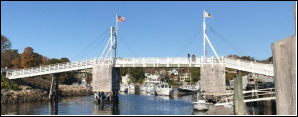
Archeological Resources in Ogunquit
Threats to Historic and Archaeological Resources
As residential construction has increased within Ogunquit, this has frequently involved the demolition of older homes to construct new homes. The cost of maintaining older homes and buildings can result in deferred care that negatively impacts building integrity, as has been the case with the Ogunquit Village School. The town monitors development and construction to protect historic sites, but there is concern among residents that the historic atmosphere and charm of the town could be at risk.
There are many risks facing the town’s historical sites. The Ogunquit Village School is one example. Other historic buildings not listed as such under the guidelines of Ogunquit Municipal Ordinance 97 Article III §97-9, have been demolished; Design Review can require modifications to the architectural design, but cannot always protect the structure itself from demolition. The Marginal Way has repeatedly suffered damage from storms in the past, and sea level rise presents further risks.
Goals, Policies and Strategies
Goal
- To protect, preserve and inventory the historic structures, sites, significant archeologicalresources and character in Ogunquit and ensure changes are carried out to minimize adverse impacts to such
Policies:
- Tocontinue to protect the significant historic and archaeological resources in the
- Tocommunicate Ogunquit’s rich history with residents and
- Toimprove documentation of Ogunquit’s historical resources and risks to those
Strategies:
- Priority: 1-5 with 1 being the highest priority.
| Description | Priority | Responsibility |
| Complete a historic resources inventory survey to add to the Town Ordinance (Designated Historic Sites, Landmarks, and Structures) for future protection, including those outside the district requiring design review. | 1 | OHPC |
| Ensure that new and modernized municipal structures maintain the charm of Ogunquit’s history. | 2 | Planning Board |
| Analyze and make recommendations on tightening Historic building restrictions. | 3 | Planning Board |
| Preserve and protect the Marginal Way coastline, with its unique geological features and its historic role in Native American life. | 4 | Marginal Way Committee |
| Analyze and make recommendations enhancing OHPC authority including the creation of historic preservation districts. | 5 | Select Board |
| Amend the Ogunquit Zoning Ordinance to require that all new construction incorporate maps and information provided by the Maine Historic Preservation Commission into the application process. | Planning Board | |
| Develop accessible resources for maintaining and communicating Ogunquit’s history including a historical and architectural digital archive. | OHPC | |
| Conduct a public ceremony to unveil the National Register of Historic Places plaque for the Marginal Way. | Marginal Way Committee | |
| Celebrate the 100th anniversary of the Marginal Way in 2025. | Select Board | |
| Analyze and make recommendations for incentivizing the preservation of historic homes. | OHPC | |
| Analyze and make recommendations on whether the 1930 date for design review should be updated to older than 50 years in the OZO. | CEO | |
| Amend OZO to require protection of known prehistoric and historic archeological sites during any construction activities. | Planning Board | |
| Work with the Heritage Museum, Wells-Ogunquit Historical Society and the Maine Historic Preservation Commission to assess the need for and, if necessary, develop a plan for a comprehensive community survey of the Town’s archaeological resources. | OHPC | |
| Update Municipal Ordinance §97-11 A to reflect additions approved by voters on 04/07/2007 | Town Manager | |
| Add a Demolition Delay provision to the OZO, per Maine Historic Preservation Commission recommendation | Planning Board |